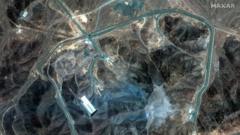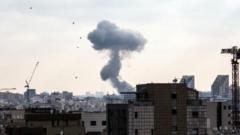In a dramatic shift in U.S. foreign policy, President Trump has authorized a joint military operation with Israel targeting Iran's critical nuclear infrastructure. Pentagon sources reported that the U.S. conducted a series of airstrikes on the Isfahan, Natanz, and Fordo nuclear sites, claiming to inflict "severe damage" to these pivotal locations. Despite official assertions of significant destruction, top defense officials indicated that the full status of Iran's nuclear capabilities remains uncertain.
U.S. Bombs Iranian Nuclear Sites Amid Escalating Tensions

U.S. Bombs Iranian Nuclear Sites Amid Escalating Tensions
Recent strikes against Iranian nuclear facilities escalate fears of wider conflict as U.S. officials attempt to clarify the intent behind military action.
Further complicating the narrative, reports suggest that while Trump asserted that sites had been "completely and totally obliterated," U.S. intelligence recognized that certain fortified areas, especially Fordo, may still retain remnants of operational capacity due to preemptive measures taken by Iranian officials. Meanwhile, Iranian Foreign Minister has condemned the attacks, warning of detrimental impacts on potential diplomatic engagements headed towards de-escalation. Inside Iran, anxiety and discontent among civilians have surfaced, mirrored by international calls for restraint from various world leaders.
Looking ahead, the implications of the U.S. partnership in these strikes may signal a concerning new phase of military confrontation. Analysts speculate that Iran's reaction could strengthen its resolve towards nuclear armament, raising alarm regarding the potential for a broader conflict in an already volatile region.
Looking ahead, the implications of the U.S. partnership in these strikes may signal a concerning new phase of military confrontation. Analysts speculate that Iran's reaction could strengthen its resolve towards nuclear armament, raising alarm regarding the potential for a broader conflict in an already volatile region.






















